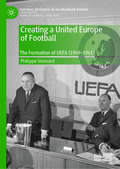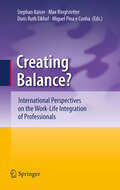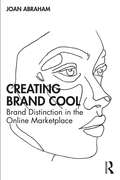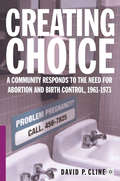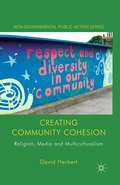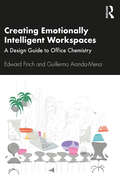- Table View
- List View
Creating a United Europe of Football: The Formation of UEFA (1949–1961) (Football Research in an Enlarged Europe)
by Philippe VonnardThis book provides a historical study of the beginnings of the UEFA, demonstrating how the formation of the organisation was linked to the decentralisation experienced by FIFA, the world governing body of football. Vonnard examines why administrators created an association that transcended the barriers of the Cold War, and focused on the development of a network that promoted football outside the constraints of international politics. Finally, he emphasises the role UEFA played in the Europeanisation of the people’s game, and in the early years of the European integration process. The research is based on a rich body of new archival material from the UEFA and FIFA Documentation Centres, and various European football federations, as well as reports from a number of leading newspapers of the era, and interviews with football personalities of the 1950s. It will be of interest to students and scholars across the history of sport, international relations, and European studies
Creating an Effective Management System: Integrating Policy Deployment, TWI, and Kata
by Patrick Graupp Skip Steward Brad Parsons"The decades of experience-based wisdom that Graupp, Steward and Parsons share will set you on a new path to a more joyful organization and the tangible results it will produce." Rich Sheridan, CEO, Menlo Innovations; author of Joy, Inc. and Chief Joy Officer "A fine book by skilled practitioners that integrates Kata and TWI, with Strategy Deployment in pursuit of an integrated management system. Well done, Skip, Brad and Patrick." Pascal Dennis, president, Lean Pathways Inc.; author of Lean Production Simplified, Andy & Me, Andy & Me and the Hospital, Getting the Right Things Done, and The Remedy "In this practical and engaging book, Patrick Graupp, Skip Steward, and Brad Parsons give a concise and extremely clear explanation of what systems thinking looks like in a healthcare setting. And they do so in a way that translates easily to any type of organization. Highly recommended!" Alan Robinson, co-author of Ideas Are Free and The Idea-Driven Organization Despite the vast library of knowledge on Lean tools and models, the majority of Lean implementations fail to sustain themselves over time for lack of a functioning management system. In turn, when organizations try to apply a prescribed, one-size-fits-all, management system they inevitably find that what works for others may not work quite as well in their unique situation. Putting the right pieces in the right places is the prime challenge for every organization and no two successful management systems will, or should, be the same. This book provides and examines core principles that must be in place for an organization to find what an effective management system should constitute for them. It outlines key elements and how they work together as a necessary system to achieve overall success. Based on their extensive experience with organizational development and hands-on leadership in policy deployment, TWI and Kata, the authors describe their own journey in helping organizations discover and develop systems that function like well-designed and smooth-running machines while capturing the humanistic aspects of the foundational skills that emphasize the inherent synergy of the system. Readers will learn to help their own organizations "connect the dots" between the various pieces of Lean methodology and effectively create their own management systems that ultimately fulfil customers’ needs and expectations.
Creating an Effective Management System: Integrating Policy Deployment, TWI, and Kata
by Patrick Graupp Skip Steward Brad Parsons"The decades of experience-based wisdom that Graupp, Steward and Parsons share will set you on a new path to a more joyful organization and the tangible results it will produce." Rich Sheridan, CEO, Menlo Innovations; author of Joy, Inc. and Chief Joy Officer "A fine book by skilled practitioners that integrates Kata and TWI, with Strategy Deployment in pursuit of an integrated management system. Well done, Skip, Brad and Patrick." Pascal Dennis, president, Lean Pathways Inc.; author of Lean Production Simplified, Andy & Me, Andy & Me and the Hospital, Getting the Right Things Done, and The Remedy "In this practical and engaging book, Patrick Graupp, Skip Steward, and Brad Parsons give a concise and extremely clear explanation of what systems thinking looks like in a healthcare setting. And they do so in a way that translates easily to any type of organization. Highly recommended!" Alan Robinson, co-author of Ideas Are Free and The Idea-Driven Organization Despite the vast library of knowledge on Lean tools and models, the majority of Lean implementations fail to sustain themselves over time for lack of a functioning management system. In turn, when organizations try to apply a prescribed, one-size-fits-all, management system they inevitably find that what works for others may not work quite as well in their unique situation. Putting the right pieces in the right places is the prime challenge for every organization and no two successful management systems will, or should, be the same. This book provides and examines core principles that must be in place for an organization to find what an effective management system should constitute for them. It outlines key elements and how they work together as a necessary system to achieve overall success. Based on their extensive experience with organizational development and hands-on leadership in policy deployment, TWI and Kata, the authors describe their own journey in helping organizations discover and develop systems that function like well-designed and smooth-running machines while capturing the humanistic aspects of the foundational skills that emphasize the inherent synergy of the system. Readers will learn to help their own organizations "connect the dots" between the various pieces of Lean methodology and effectively create their own management systems that ultimately fulfil customers’ needs and expectations.
Creating an Information Security Program from Scratch
by Walter WilliamsThis book is written for the first security hire in an organization, either an individual moving into this role from within the organization or hired into the role. More and more, organizations are realizing that information security requires a dedicated team with leadership distinct from information technology, and often the people who are placed into those positions have no idea where to start or how to prioritize. There are many issues competing for their attention, standards that say do this or do that, laws, regulations, customer demands, and no guidance on what is actually effective. This book offers guidance on approaches that work for how you prioritize and build a comprehensive information security program that protects your organization. While most books targeted at information security professionals explore specific subjects with deep expertise, this book explores the depth and breadth of the field. Instead of exploring a technology such as cloud security or a technique such as risk analysis, this book places those into the larger context of how to meet an organization's needs, how to prioritize, and what success looks like. Guides to the maturation of practice are offered, along with pointers for each topic on where to go for an in-depth exploration of each topic. Unlike more typical books on information security that advocate a single perspective, this book explores competing perspectives with an eye to providing the pros and cons of the different approaches and the implications of choices on implementation and on maturity, as often a choice on an approach needs to change as an organization grows and matures.
Creating an Information Security Program from Scratch
by Walter WilliamsThis book is written for the first security hire in an organization, either an individual moving into this role from within the organization or hired into the role. More and more, organizations are realizing that information security requires a dedicated team with leadership distinct from information technology, and often the people who are placed into those positions have no idea where to start or how to prioritize. There are many issues competing for their attention, standards that say do this or do that, laws, regulations, customer demands, and no guidance on what is actually effective. This book offers guidance on approaches that work for how you prioritize and build a comprehensive information security program that protects your organization. While most books targeted at information security professionals explore specific subjects with deep expertise, this book explores the depth and breadth of the field. Instead of exploring a technology such as cloud security or a technique such as risk analysis, this book places those into the larger context of how to meet an organization's needs, how to prioritize, and what success looks like. Guides to the maturation of practice are offered, along with pointers for each topic on where to go for an in-depth exploration of each topic. Unlike more typical books on information security that advocate a single perspective, this book explores competing perspectives with an eye to providing the pros and cons of the different approaches and the implications of choices on implementation and on maturity, as often a choice on an approach needs to change as an organization grows and matures.
Creating an LGBT+ Inclusive Workplace: The Practical Resource Guide for Business Leaders
by Kryss ShaneSetting out best practices and professional guidance for creating LGBT+ inclusive workplaces, this approachable and easy to follow book guides current and future leaders of all industries toward appropriate and proven ways to create safer working environments, update company policies, enhance continuing education and training, and better support LGBT+ people in the workplace. Featuring real-life situations and scenarios, a glossary, and further resources, Creating an LGBT+ Inclusive Workplace enables professionals in all aspects of professional roles to integrate foundational concepts into their everyday interactions with staff at all levels as well as within the community to create an overall workplace culture that nurtures a welcoming, inclusive, and affirming environment for all. This book includes postcards from PostSecret as its foreword and more than a dozen exclusive interviews from the world’s top leaders in a variety of industries with world-renowned reputations. Enabling professionals in a variety of business roles to create an overall workplace culture that nurtures a welcoming, inclusive, and affirming environment for all, this book is an essential resource for independent readers, department teams, and entire corporations.
Creating an LGBT+ Inclusive Workplace: The Practical Resource Guide for Business Leaders
by Kryss ShaneSetting out best practices and professional guidance for creating LGBT+ inclusive workplaces, this approachable and easy to follow book guides current and future leaders of all industries toward appropriate and proven ways to create safer working environments, update company policies, enhance continuing education and training, and better support LGBT+ people in the workplace. Featuring real-life situations and scenarios, a glossary, and further resources, Creating an LGBT+ Inclusive Workplace enables professionals in all aspects of professional roles to integrate foundational concepts into their everyday interactions with staff at all levels as well as within the community to create an overall workplace culture that nurtures a welcoming, inclusive, and affirming environment for all. This book includes postcards from PostSecret as its foreword and more than a dozen exclusive interviews from the world’s top leaders in a variety of industries with world-renowned reputations. Enabling professionals in a variety of business roles to create an overall workplace culture that nurtures a welcoming, inclusive, and affirming environment for all, this book is an essential resource for independent readers, department teams, and entire corporations.
Creating Authentic Organizations: Bringing Meaning and Engagement Back to Work
by Robin Ryde Lisa SofianosOur identity is often bound up what we do at work. The work we do goes some way to describing who we are, what we stand for and it reveals, in one dimension at least, a tangible and valued contribution that we make to the world. Authenticity in organizations matters more than ever.In today's complex and global economy it's more important than ever that we empower employees to bring their authentic selves to work. Doing so leads to increased innovation, productivity, more thoughtful risk-taking, a sense of responsibility and enhanced adaptiveness to change. Creating Authentic Organizations goes beyond the remit of authentic leadership and shows how the concept of authenticity can and should be applied to your organization. It offers a new management framework based on the freedom to operate, meaningful dialogue and a deep search for personal meaning at work; autonomy and the opportunity to make an impact is a key driver of productivity.With simple and powerful models and strategies to bring about workplace authenticity, this bold and cutting-edge approach will show you how to ensure more authentic dialogue and encourage open and meaningful discussion around threats and challenges. Creating Authentic Organizations gives you the tools to bridge the gap between the corporate persona and the authentic self, leading to greater employee engagement, well-being and organizational resilience. Online supporting resources include an authenticity and freedoms diagnostic tool and guidance notes.
Creating Authentic Organizations: Bringing Meaning and Engagement Back to Work
by Robin Ryde Lisa SofianosOur identity is often bound up what we do at work. The work we do goes some way to describing who we are, what we stand for and it reveals, in one dimension at least, a tangible and valued contribution that we make to the world. Authenticity in organizations matters more than ever.In today's complex and global economy it's more important than ever that we empower employees to bring their authentic selves to work. Doing so leads to increased innovation, productivity, more thoughtful risk-taking, a sense of responsibility and enhanced adaptiveness to change. Creating Authentic Organizations goes beyond the remit of authentic leadership and shows how the concept of authenticity can and should be applied to your organization. It offers a new management framework based on the freedom to operate, meaningful dialogue and a deep search for personal meaning at work; autonomy and the opportunity to make an impact is a key driver of productivity.With simple and powerful models and strategies to bring about workplace authenticity, this bold and cutting-edge approach will show you how to ensure more authentic dialogue and encourage open and meaningful discussion around threats and challenges. Creating Authentic Organizations gives you the tools to bridge the gap between the corporate persona and the authentic self, leading to greater employee engagement, well-being and organizational resilience. Online supporting resources include an authenticity and freedoms diagnostic tool and guidance notes.
Creating Balance?: International Perspectives on the Work-Life Integration of Professionals
by Stephan Kaiser, Max Josef Ringlstetter, Doris Ruth Eikhof and Miguel Pina e CunhaA satisfactory and healthy integration of work with other life domains is one of the key challenges of modern society. Work-life balance and work-life integration have become focal points of today’s human resource management practice and theory. Professionals who have been described as “extreme workers” regarding their work hours and engagement are under particular pressure to balance work and ”the rest of life”.This collection maps the increasingly extensive discussion of work-life issues for professionals and discusses key aspects in depth. What is work-life integration? What are the specific challenges for professionals? How do they manage their blurred work-life boundaries? How can companies intervene? Internationally leading authors discuss antecedents and individual and organizational outcomes of work-life integration, gender-specific perspectives and challenges as well as the use and usefulness of corporate work-life balance initiatives. In five sections distinguished researchers from across the world present experiences and research findings to provide a compendium of academic and applied research on the work-life integration of professionals. Cutting-edge research and novel theoretical perspectives make this collection a source of knowledge and inspiration for academic and business audiences interested in work-life integration issues in general and in the case of professionals in particular.
Creating Belonging in San Francisco Chinatown’s Diasporic Community: Morphosyntactic Aspects of Indexing Ethnic Identity
by Adina StaicovThis book presents a much-needed discussion on ethnic identification and morphosyntactic variation in San Francisco Chinatown—a community that has received very little attention in linguistic research. An investigation of original, interactive speech data sheds light on how first- and second-generation Chinese Americans signal (ethnic) identity through morphosyntactic variation in English and on how they co-construct identity discursively. After an introduction to the community’s history, the book provides background information on ethnic varieties in North America. This discussion grounds the present book within existing research and illustrates how studies on ethnic varieties of English have evolved. The book then proceeds with a description of quantitative and qualitative results on linguistic variation and ethnic identity. These analyses show how linguistic variation is only one way of signalling belonging to a community and highlight that Chinese Americans draw on a variety of sources, most notably the heritage language, to construct and negotiate (ethnic) identity. This book will be of particular interest to linguists - particularly academics working in sociolinguistics, language and identity, and language variation - but also to scholars interested in related issues such as migration, discrimination, and ethnicity.
Creating Brand Cool: Brand Distinction in the Online Marketplace
by Joan AbrahamIn this intriguing blend of branding how-to and business memoir, an industry pioneer presents the thought process and tools to create a successful Ecommerce business by developing a distinct emotional attraction to a brand, beyond individual product offerings. Leveraging her 26 years of experience in online marketing and branding, Joan Abraham reveals the thought process behind successfully addressing today’s marketing challenge: clearly defining the business’s brand essence using its owned social media channels to personalize the full character of the brand. Creating Brand Cool addresses the importance of developing a unique state of being that personally resonates with today’s consumer. Abraham energizes the creative and strategic thinking for attracting and maintaining brand loyalty when the competition is a click away. Appealing to branding and social media marketing professionals, as well as students in these fields, this book is a primer for building an online community and distinguishing a brand from the competition. It is relevant to all types of business, from small businesses to globally recognized brands.
Creating Brand Cool: Brand Distinction in the Online Marketplace
by Joan AbrahamIn this intriguing blend of branding how-to and business memoir, an industry pioneer presents the thought process and tools to create a successful Ecommerce business by developing a distinct emotional attraction to a brand, beyond individual product offerings. Leveraging her 26 years of experience in online marketing and branding, Joan Abraham reveals the thought process behind successfully addressing today’s marketing challenge: clearly defining the business’s brand essence using its owned social media channels to personalize the full character of the brand. Creating Brand Cool addresses the importance of developing a unique state of being that personally resonates with today’s consumer. Abraham energizes the creative and strategic thinking for attracting and maintaining brand loyalty when the competition is a click away. Appealing to branding and social media marketing professionals, as well as students in these fields, this book is a primer for building an online community and distinguishing a brand from the competition. It is relevant to all types of business, from small businesses to globally recognized brands.
Creating Business and Corporate Strategy: An Integrated Strategic System (Routledge Focus on Business and Management)
by Adyl AliekperovBusinesses need strategies that determine the direction of functioning and further development. If a company deals with several multifaceted businesses, each of them subsequently requires their own strategy. The issue of strategy creation and realization is a key factor that must receive the closest possible attention. In order to assure victory and be thoroughly prepared for various directions and situations that may arise, companies create their own unique strategies. This book is primarily aimed at suggesting the necessary repertoire of knowledge and skills for strategy creating with the help of the TASGRAM integrated system – Thinking, Analyzing, Strategy, Goals, Risks, Actions, and Monitoring. The main outcome of TASGRAM is a combined strategic table: business strategy, corporate strategy, goals, risks, actions, and monitoring. Each element in TASGRAM has a concrete goal and it helps users become more focused. Creating Business and Corporate Strategy: An Integrated Strategic System offers a new tool for company strategy creation, showcasing various cases and examples based on theory and practice. Unlike the existing tools, the suggested system of strategy creation is simpler and definite. Its main purpose is to help create and further develop the created strategy, making this book especially valuable to researchers, academics, practitioners, and students in the fields of strategy, leadership, and management.
Creating Business and Corporate Strategy: An Integrated Strategic System (Routledge Focus on Business and Management)
by Adyl AliekperovBusinesses need strategies that determine the direction of functioning and further development. If a company deals with several multifaceted businesses, each of them subsequently requires their own strategy. The issue of strategy creation and realization is a key factor that must receive the closest possible attention. In order to assure victory and be thoroughly prepared for various directions and situations that may arise, companies create their own unique strategies. This book is primarily aimed at suggesting the necessary repertoire of knowledge and skills for strategy creating with the help of the TASGRAM integrated system – Thinking, Analyzing, Strategy, Goals, Risks, Actions, and Monitoring. The main outcome of TASGRAM is a combined strategic table: business strategy, corporate strategy, goals, risks, actions, and monitoring. Each element in TASGRAM has a concrete goal and it helps users become more focused. Creating Business and Corporate Strategy: An Integrated Strategic System offers a new tool for company strategy creation, showcasing various cases and examples based on theory and practice. Unlike the existing tools, the suggested system of strategy creation is simpler and definite. Its main purpose is to help create and further develop the created strategy, making this book especially valuable to researchers, academics, practitioners, and students in the fields of strategy, leadership, and management.
Creating Change in Mental Health Organizations: Pergamon General Psychology Series
by George W. Fairweather David H. Sanders Louis G. TornatzkyCreating Change in Mental Health Organizations discusses the findings of the experiment designed to identify the parameters of social change in mental health organizations. The title details the results from a variety of perspectives, such as experimental and hospital employees. The text first covers the need for social change in treating mental illness, and then proceeds to tackling organizational change background and research plan of the experiment. Next, the selection talks about the process of approach and persuasion. The next chapters cover the concerns in activating adoption, such as the factors, process, and conditions. Chapter 7 deals with the follow-up diffusion for the community lodge, while Chapter 8 talks about the principles for creating change in metal health organizations. The text also discusses the social policy decision aimed at solving human problems. The book will be of great use to professionals in the mental health care industry.
Creating Choice: A Community Responds to the Need for Abortion and Birth Control, 1961-1973 (Palgrave Studies in Oral History)
by D. ClineBefore Roe v. Wade, somewhere between one and two million illegal abortions were performed every year in the United States. Illegal abortion affected millions of women and their families, yet their stories remain hidden. In Creating Choice , citizens of one community in Western Massachusetts' Pioneer Valley break that silence.
Creating Citizenship Communities: Education, Young People and the Role of Schools
by V. Sundaram I. Davies G. Hampden-Thompson M. Tsouroufli G. Bramley T. Breslin T. ThorpeOn the basis of a national research project undertaken in England, this volume explores how and why young people's engagement is so important globally in education and society, and looks at what teachers and students think about citizenship and community. The authors make recommendations to enhance understanding and the potential for engagement.
Creating Community Cohesion: Religion, Media and Multiculturalism (Non-Governmental Public Action)
by D. HerbertUsing approaches from sociology, media and religious studies, David Herbert compares recent public controversies involving or implicating religion in the UK (England and Northern Ireland), the Netherlands and France.
Creating Conditions for Promising Collaboration: Alliances, Networks, Chains, Strategic Partnerships (SpringerBriefs in Business)
by Edwin Kaats Wilfrid OpheijThis publication focuses on the conditions for promising collaboration. Collaboration is becoming a dominant instrument in today's economy and society and manifests itself in many shapes and forms. It is a challenging instrument which still isn't very well understood and poses the business community in front of a number of challenging dilemma's. We position collaboration as a multidisciplinary phenomenon and - based on years of research and as reflective practitioners - offer a comprehensive model for analyzing and designing collaborative processes that is both scientifically rooted and applicable in practice. A better understanding of collaborative processes will enhance the success of alliances, networks, chains and strategic partnerships. In addition to this we look to the future of organizing from a collaborative perspective and address the challenges ahead.
Creating Culture in (Post) Socialist Central Asia
by Ananda Breed Eva-Marie Dubuisson Ali IğmenThis book brings together historical and ethnographic research from Kyrgyzstan, Kazakhstan, and Xinjiang, in order to explore how individuals and communities work to create and maintain forms of ‘culture’ in contexts of ideological repression and erasure. Across Inner Central Asia, in both China and the Soviet Union, while ethnic culture was on one hand lauded and promoted, it was simultaneously folklorized in the face of broader projects of socialist modernity. How do local intellectuals, cultural organizers, and performers work to negotiate their own forms and understandings of cultural meaning within the institutions and frameworks of a long twentieth century? How does scholarly attention to cultural production, tradition, and performance help to inform our understanding of (ethnic) nations not as given, but as coming into being?
Creating Culture Through Media and Communication (Studies in Media and Communications #24)
by Sonia Virgínia Moreira Katia Moles Laura Robinson Jeremy SchulzSponsored by the Brazil-U.S.Colloquium on Communication Studies of the Brazilian Society for Interdisciplinary Studies in Communication and the Communication, Information Technologies, and Media Sociology Section of the American Sociological Association (CITAMS), this volume of Emerald Studies in Media and Communications is entitled Creating Culture Through Media and Communication. The volume is a vibrant collaboration of global voices addressing the media and communications challenges of our time. Contributors ask us to reconsider the ethical implications of media and technology from historical, contemporary, and future perspectives. In addition, case studies show the diverse ways that cultural media production has ripple effects throughout larger society. Authors ask important questions about how digitalization is shaping our everyday lives, as well as how the ethics of tech is needed now more than ever with the sea change occasioned by AI.
Creating Culture Through Media and Communication (Studies in Media and Communications #24)
by Sonia Virginia Moreira, Katia Moles, Laura Robinson, Jeremy Schulz, Joseph Straubhaar, Cara Chiaraluce, John R. Baldwin and Juliana TrammelSponsored by the Brazil-U.S.Colloquium on Communication Studies of the Brazilian Society for Interdisciplinary Studies in Communication and the Communication, Information Technologies, and Media Sociology Section of the American Sociological Association (CITAMS), this volume of Emerald Studies in Media and Communications is entitled Creating Culture Through Media and Communication. The volume is a vibrant collaboration of global voices addressing the media and communications challenges of our time. Contributors ask us to reconsider the ethical implications of media and technology from historical, contemporary, and future perspectives. In addition, case studies show the diverse ways that cultural media production has ripple effects throughout larger society. Authors ask important questions about how digitalization is shaping our everyday lives, as well as how the ethics of tech is needed now more than ever with the sea change occasioned by AI.
Creating Emotionally Intelligent Workspaces: A Design Guide to Office Chemistry
by Edward Finch Guillermo Aranda-MenaEmotions in the workplace have until recently been seen simply as a distraction. We often think of work as rational, logical and non-emotional. But organisations are waking up to the key role of emotions and affect at work. Emotions influence how we make decisions, how we relate with one another and how we make sense of our surroundings. Whilst organisations are slowly embracing the pivotal role of emotions, designers and managers of workplaces have been struggling to keep up. New insights from hard sciences such as neuropsychology are presenting a radically different interpretation of emotions. Yet workplace designers and facilities managers still rely on measuring non-specific states such as satisfaction and stress. In this book we attempt to capture modern-day interpretations of emotion, looking at emotion in terms of transactions and processes rather than simple cause and effect. We entertain the idea of an ‘emotionally intelligent building’ as an alternative to the much-hyped intelligent building. The assertion is that we should create environments that are emotionally intelligent. Rather than focusing on the aptitudes or shortcomings of individuals at work, we should place closer attention on the office environment. It’s not that we are emotionally disabled – it’s the environment that disables us! The ability of you and me to interpret, control and express emotions may not simply be a result of our own make-up. A radically different outlook considers how our workspace and workplace debilitates or enables our emotional understanding. In the modern workplace there are many innovations that can undermine our emotional intelligence, such poorly implemented hot-desking or lean environments. Contrariwise there are key innovations such as Activity Based Working (ABW) that have the potential to enhance our emotional state. Through a series of unique case studies from around the world, we investigate key concepts that can be used by designers and facilities managers alike. No longer should designers be asked to incorporate emotional elements as intangible un-costed ‘add-ons’. This book provides a shot in the arm for workplace design professionals, pointing to a new way of thinking based on the emotional intelligence of the workplace.
Creating Emotionally Intelligent Workspaces: A Design Guide to Office Chemistry
by Edward Finch Guillermo Aranda-MenaEmotions in the workplace have until recently been seen simply as a distraction. We often think of work as rational, logical and non-emotional. But organisations are waking up to the key role of emotions and affect at work. Emotions influence how we make decisions, how we relate with one another and how we make sense of our surroundings. Whilst organisations are slowly embracing the pivotal role of emotions, designers and managers of workplaces have been struggling to keep up. New insights from hard sciences such as neuropsychology are presenting a radically different interpretation of emotions. Yet workplace designers and facilities managers still rely on measuring non-specific states such as satisfaction and stress. In this book we attempt to capture modern-day interpretations of emotion, looking at emotion in terms of transactions and processes rather than simple cause and effect. We entertain the idea of an ‘emotionally intelligent building’ as an alternative to the much-hyped intelligent building. The assertion is that we should create environments that are emotionally intelligent. Rather than focusing on the aptitudes or shortcomings of individuals at work, we should place closer attention on the office environment. It’s not that we are emotionally disabled – it’s the environment that disables us! The ability of you and me to interpret, control and express emotions may not simply be a result of our own make-up. A radically different outlook considers how our workspace and workplace debilitates or enables our emotional understanding. In the modern workplace there are many innovations that can undermine our emotional intelligence, such poorly implemented hot-desking or lean environments. Contrariwise there are key innovations such as Activity Based Working (ABW) that have the potential to enhance our emotional state. Through a series of unique case studies from around the world, we investigate key concepts that can be used by designers and facilities managers alike. No longer should designers be asked to incorporate emotional elements as intangible un-costed ‘add-ons’. This book provides a shot in the arm for workplace design professionals, pointing to a new way of thinking based on the emotional intelligence of the workplace.
